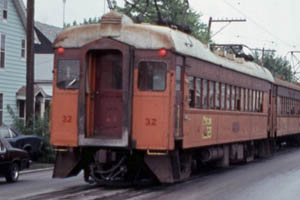
- Builder
- Standard Steel Car Co.
- Description
- Steel interurban coach with smoker
- Secondary Use
- None
- Type
- Interurban Cars
- Year
- 1929
- Retired from Service
- 1983
- Acquired by the Museum
- 1989
- Note
- The car requires body and interior rehabilitation as well as roof renewal. The car body was also distorted in a railroad accident while being moved to the museum. As of August 2021, No. 32 is mostly covered by a tarp.
South Shore Line 32
From Chicago, Illinois
History
Between 1903 and 1909, the Chicago Lake Shore & South Bend Railroad built an interurban line between South Bend, IN and Kensington, on the south side of Chicago. In 1925, utilities magnate, Samuel Insull, acquired control of the line and reorganized it as the Chicago South Shore & South Bend Railroad. Insull undertook a massive rejuvenation with improved track, stations and electrical systems. Insull gained trackage rights over the Illinois Central Railroad for through service to downtown Chicago. The upgrades also included a new fleet of heavyweight, steel cars to replace the old CLS&SB wood cars. Between 1926 and 1929, the South Shore acquired 52 steel passenger cars. No. 32 is one of 15 coaches (No. 10 and Nos. 26-39) purchased from Standard Steel Car in 1929. The 1929 order from Standard Steel also included two unpowered coaches and two parlor cars. No. 32 featured bucket seats and an enclosed smoking compartment. Between 1943 and 1951, the South Shore modernized about half of its passenger fleet by lengthening the cars, installing large, picture windows and adding air conditioning, but No. 32 did not get this treatment. The South Shore’s heavyweight steel cars remained in service until replacement by new, state-financed cars in 1983.
The Insull upgrades, the IC’s main line access to Chicago and a thriving freight business serving heavy industry in northern Indiana helped make the South Shore the nation’s only surviving electric interurban. Passenger Service is now operated by the Northern Indiana Commuter Transportation District. Freight service is privately owned and still operates as the Chicago South Shore & South Bend Railroad.
In 1983, the National Park Service acquired No. 32 along with 17 other South Shore heavyweight cars for a planned shuttle from the South Shore to the Indiana Dunes National Lakeshore. Many of the other South Shore heavyweight cars went to museums or private ownership. The Park Service stored its cars inside the Abex Stanray plant in Hammond, IN and later in a U.S. Steel bar mill at Gary, IN. The rail shuttle was never built. So, in 1989, the Park Service offered its South Shore cars to museums. No. 32 came to Seashore on a ten year loan from the National Park Service. In 2010, the museum acquired ownership from the Park Service. The NPS asked to maintain an ongoing working relationship with Seashore through the joint development of interpretive media, and the NPS sought to provide for No. 32’s long-term preservation.
At Seashore, No. 32 joined cars from the other two principal Chicago-area interurbans that had also been controlled by Samuel Insull. These other cars – Chicago Aurora & Elgin No. 434 and Chicago North Shore & Milwaukee Nos. 415, 420 and 755 – were all built in the same era as No. 32 as part of Insull’s fleet upgrades.
Technical Information
- Seats: 48
- Control: HBF
- Brakes: AMU
- Compressor: D-3-F
Trucks
- Number: 2
- Manufacturer: Baldwin
- Model: 84-60AA
Motor
- Number: 4
- Manufacturer: Westinghouse
- Model: 567-C11
Weight and Dimensions
- Length: 61’
- Width: 10’ 1.00"
- Height: 14’ 6.00"
- Weight: 133600 lbs.
Additional Images

At Michigan City old shops at newdavesrailpix.com
© 1998 - 2025 New England Electric Railway Historical Society. All Rights Reserved.